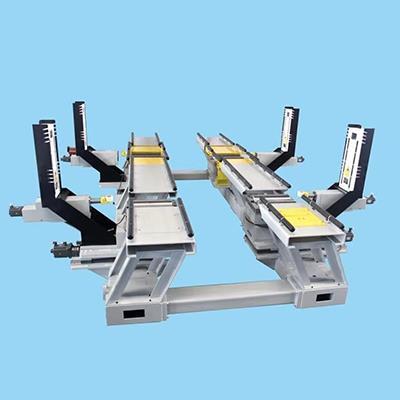1. Before doing 4-wheel alignment, it is very important to understand the symptoms of the customer's car when driving. By listening carefully to the customer's feedback and carefully observing the characteristics of tire wear, it is usually possible to roughly determine whether the symptoms of the car are caused by 4-wheel misalignment. When the customer cannot accurately explain the fault of the car, the technician needs to test the car in person to determine the fault.
2. Calibrate the corner plate and rear slide plate, calibrate the net width of the lift according to the wheelbase and wheelbase of the vehicle being tested, and lock the corner plate and rear slide plate with the locking rod.
3. Drive the car onto the 4-post lifting positioning platform, with the front tires parked on the corner plate and the rear tires parked on the rear slide of the positioning platform. The wheels should be in the middle of the rear slide and the service brakes should be tightened.
4. Check the wheel rim and tire size. Each tire size should be the same. Check the tread thickness and tire pressure. Check the clearance between the steering device and the axle, the status of the spring device and the shock absorber. Measure whether the two sides of the car body are the same.

5. Release the brakes and press down the front and rear sides of the vehicle to return the spring shock absorber to the middle position.
6. Use a secondary lift to lift the car and check whether the ball heads of the horizontal and vertical tie rods are loose; check whether the rubber sleeves of the upper and lower swing arms are cracked or loose; move the tires to check whether the bearings are loose; check whether the brake pipes are leaking oil, the degree of wear of the brake pads, etc.
After completing the above inspection items, you can install the brake lock, lock the brake plate, install the clamps and sensors on all wheels, and adjust them with the bubble level. Connect the power supply of the 3D laser 4-wheel aligner and input the positions of the 4 sensors. Unplug the lock rod that locks the corner plate and rear skateboard, and you can perform 4-wheel alignment.
7. Turn on the computer, enter the main menu, and select Start new positioning monitoring\/Sequential positioning detection\/Preparation before detection\/Detection before adjustment\/Positioning adjustment\/Detection after adjustment\/Print\/End, etc. During the detection process, follow the on-screen prompts to operate.
Although different 4-wheel alignment instruments have different operations, the overall detection process is similar. You only need to master one or several of them to apply them to other situations and perform 4-wheel alignment detection proficiently.
Related News
- How does the dynamic four wheel aligner avoid communication interference?
- Introduction to vehicle electrical inspection
- How to choose a good pass four wheel aligner
- What is the assembly line
- The important role of the through four wheel aligner
- The four main points of 3D laser four wheel aligner maintenance
- Working principle of electric chassis dynamometer
- Vehicle off-line comprehensive diagnostic equipment
- How to choose a good dynamic four wheel aligner
- Precautions for selecting a non-contact four-wheel aligner
- What are the characteristics of DSP technology of 3D laser 4 wheel alignment?
- How to maintain ABS brake system to prevent failure
- Analysis of the testing items of each parameter of dynamic 4-wheel alignment instrument
- Analysis of the selection of dynamic 4-wheel alignment instruments
- Advantages of through-type 4-wheel alignment instrument
- Introduction to the main components of the comprehensive drum test bench (2)
- What is the difference between a static 4-wheel alignment instrument in a repair shop and a dynamic surface measurement 4-wheel alignment instrument in a car factory?
- Analysis of relevant matters of 3D laser 4-wheel alignment
- Analysis of the principles and advantages of 3D laser 4-wheel alignment
- 3D laser 4 wheel alignment installation and maintenance matters
